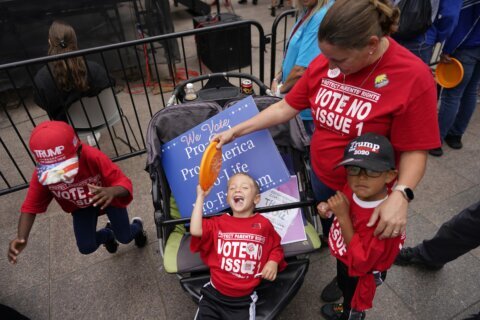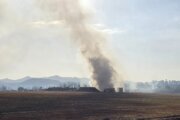OMAHA, Neb. (AP) — Scorching weather hitting nearly 100 million people across a huge swath of the U.S. forced schools and outdoor workers to scramble to adjust Tuesday — and claimed the life of a 1-year-old girl left in a Nebraska day care center’s van on one of the hottest days of the year.
Officers and medics were called Monday afternoon to Kidz of the Future Childcare in Omaha for an unresponsive baby inside the van, police said. Temperatures at the time reached into the upper 90s (mid-30s Celsius), part of a dayslong heat wave.
The child, Ra’Miyah Worthington, was pronounced dead at a hospital, police said. Court documents say her body temperature was 109 F (42.8 C). Her parents questioned why her absence at the day care wasn’t noticed.
“She loved, loved, loved her family,” her mother, Sina Johnson, told the television station WOWT. “She loved her daddy. She was daddy’s little girl.”
Prosecutors charged the 62-year-old van driver, Ryan Williams, of Omaha, on Tuesday with a felony count of child negligence resulting in death, which carries a sentence of up to four years in prison.
He told investigators that he was distracted by a young boy who didn’t want to get out of the van when he was unloading the vehicle and mistakenly forgot the girl inside, according to court documents. A second staff member came out to help get the boy, and Williams closed up the van without conducting the sweep of the vehicle that he said he normally does.
A bond hearing for Williams was set for Wednesday morning. Online court records didn’t yet list an attorney who could comment on his behalf, and a phone listing was disconnected.
“He was responsible for getting those kids inside,” said Douglas County Chief Deputy Attorney Brenda Beadle. “That little girl was in that van between five and six hours with the temperature outside reaching nearly 100.”
State officials said the day care would remain closed while the girl’s death is investigated.
The National Weather Service issued heat alerts Tuesday for parts of 22 states stretching from the Midwest and Great Plains down to the Gulf Coast.
The high temperatures in some states, including Nebraska, Iowa and parts of South Dakota, Minnesota, Kansas, Missouri, Illinois and Indiana, were expected to be as much as 20 degrees above average. Higher overnight temperatures and high humidity were expected to compound the effects of the heat, which the weather service said would stick around through Thursday and possibly into Friday.
In Missouri, firefighters helped remove 117 patients from a skilled nursing facility after the air conditioning failed in the sweltering weather. Most were taken to other nursing facilities but seven who had COVID-19 and were taken to local hospitals, authorities said.
The heat led schools across the Midwest to make changes, bringing recess indoors and postponing sports events from South Dakota to Indiana.
The annual Taste of Iowa City event was moved from Thursday to next Tuesday to avoid temperatures expected to soar over 100 degrees (37.8 Celsius).
Schools in the suburbs of Chicago delayed the start of classes to Friday or shifted to online learning and early release. Chicago Public Schools — among the country’s largest districts, with more than 340,000 students — did not announce alterations to its schedule, drawing concerns from parents about conditions and past issues with some window air conditioners.
Organizers altered plans to rally for workers’ rights outside the Republican presidential primary debate in Milwaukee, with temperatures forecast to be near 100 degrees Wednesday. A march to the debate was to go ahead, but speeches featuring U.S. Rep. Gwen Moore and others were moved to an air-conditioned hall.
Even in Florida, which is used to 90-plus temperatures in August, forecasters issued heat advisories in some areas, including Tallahassee. The heat index across the Panhandle was expected to top out at somewhere around 105 (40.5 Celsius) on Tuesday and Wednesday, according to the National Weather Service.
“The heat through this week will be the main concern. Remember to practice heat safety by staying hydrated and taking breaks while outside,” the weather service said Tuesday in a post on X, formerly known as Twitter.
The Midwest heat is a taste of what areas in the Southwest have borne. Metro Phoenix, which recorded some of the hottest weather in the U.S. this summer, in recent days has enjoyed unseasonably lower temperatures of around or under 100 after sweltering through most of July with highs at or above 110 (43.3 Celsius). Thanks to the cloud cover, the high temperature Monday at Phoenix Sky Harbor International Airport reached only 91 (32.8 Celsius).
That will change by the weekend, with a high of 109 (42.8 Celsius) forecast for Saturday.
In south Texas, 22 consecutive days of 100-plus temperatures ended in the Brownsville area Tuesday when Tropical Storm Harold brought some relief, weather service meteorologist Joshua Schroeder said. Temperatures were expected to remain in the low to mid-90s through the rest of the week, the weather service said.
The storm also brought heavy rain — up to 6 inches (15 centimeters) in some areas — in a region that has been experiencing drought, Schroeder said.
“A lot of this rainfall is actually beneficial, and as it moves inland, it will rain itself out,” Schroeder said. “And as it moves into Mexico, it will drain into the tributaries that feed a couple of the reservoirs along the Rio Grande that have been running very low, so that’s actually good for us.”
——
Contributing to this report were Associated Press journalists Josh Funk, also in Omaha; Kathleen Foody in Chicago; Freida Frisaro in Miami; Ken Miller in Oklahoma City; Scott Bauer in Madison, Wisconsin; Anita Snow in Phoenix; and Hannah Fingerhut in Des Moines, Iowa.
Copyright © 2024 The Associated Press. All rights reserved. This material may not be published, broadcast, written or redistributed.






